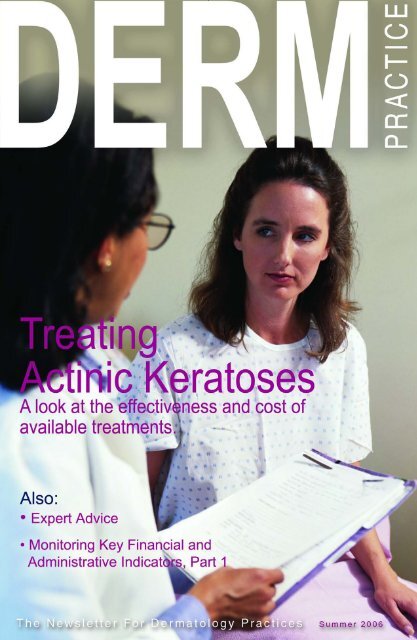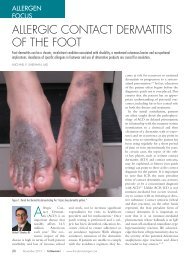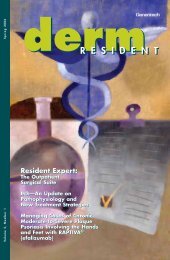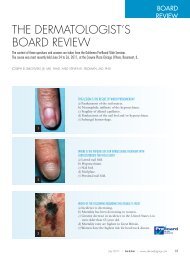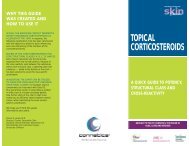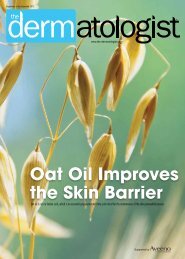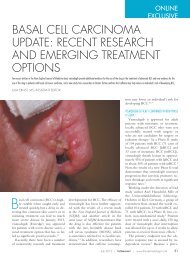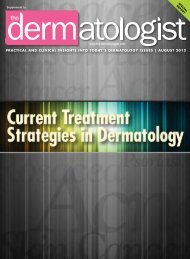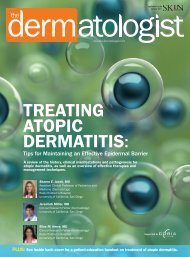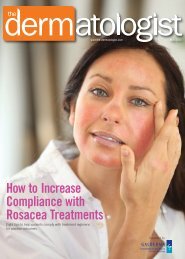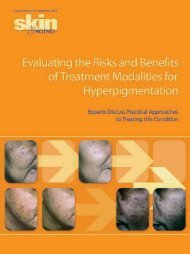Download PDF - The Dermatologist
Download PDF - The Dermatologist
Download PDF - The Dermatologist
Create successful ePaper yourself
Turn your PDF publications into a flip-book with our unique Google optimized e-Paper software.
LETTERDEAR FELLOW DERMATOLOGIST:We are pleased to bring you the latest issue of the new Derm Practice, aquarterly newsletter for practicing dermatologists.We hope this article will help you address challenges you face in yourpractice everyday. <strong>The</strong>se articles were written to provide you with easy-tofollowadvice to help you run a successful practice both clinically and on thebusiness side.Michael H. Gold, M.D.In this issue, we bring you an “Expert Advice” column where I answercommon questions about the pros and cons of using a physician extender.I also offer tips on enhancing productivity of your employees.This issue’s cover story offers an overview of the effectiveness and costof available treatments for treating actinic keratoses, from destructivemodalities to medical modalities to the use of Levulan® Kerastick®(aminolevulinic acid HCI) and photodynamic therapy (Levulan-PDT).Contributing Editor and practice management expert Gil Weber thenexplores key financial and administrative indicators that you need to reviewon a regular basis to monitor the performance and health of your practice.In part one of this two-part series, Mr. Weber offers advice on monitoringyour accounts receivable, avoiding referral hassles and delays, managingpatients’ benefits and keeping appointment lead times in check.I hope you find this issue of Derm Practice valuable and that you can usethe information you read here to enhance your practice.Please e-mail stuleya@hmpcommunications.com with any comments orsuggestions for the newsletter. I look forward to hearing from you.Sincerely,Michael H. Gold, M.D.
TREATINGACTINIC KERATOSESA LOOK AT THE EFFECTIVENESS AND COST OF AVAILABLE TREATMENTS.BY MICHAEL H. GOLD, M.D.Many patients seek dermatologycare for treatment ofactinic keratoses (AKs). AKs,in fact, rank second only to acne vulgarisin reasons patients present todermatologists.It has been estimated that morethan 4 million patients are treatedeach year for AKs. At least one AK isexpected to develop in one of everysix Americans during his or her lifetime.An AK, characterized by a dysplasiaof the keratinocytes of the epidermis,is considered a pre-malignantlesion, and according to an AKConsensus Conference in 2001, allAKs should be treated to preventprogression to a more aggressivesquamous cell carcinoma (SCC).We are very fortunate to have awide range of therapies available tochoose from to treat AKs. As physicians,we must consider manythings in deciding which of theavailable therapies is appropriatefor our patients. We need to considerefficacy, both short and longterm; tolerability of the treatment;convenience, cosmetic outcome;and, of course, cost, both to thepatient and to the physician.In the United States, more than90% of all AKs are treated by aform of destruction. <strong>The</strong> destructivemodalities are shown inTable I. Medical modalities areshown in Table II.DESTRUCTIVE THERAPIESOf all the therapies for AKs, mostdermatologists would considercryosurgery to be the gold standardfor our patients. <strong>The</strong> cure rate forcryosurgery has been reported to be98% and the procedure can easily beperformed in the physician’s office. Ina recent prospective, multicenteredclinical trial of 90 patients with AKs,cure rates were found to be lowerthan 98% and were dependent onthe time of freezing of the AK, notjust on freezing the lesion. 1 Curerates from 39% to 83% were found inthis trial. And complications, rangingfrom pain to hypopigmentation, werefrequent occurrences.Curettage and excisional surgeryallow for pathological diagnosesto be made. However, scarringis a real consequence of thesemodalities and they require a localanesthetic prior to the procedure.Subclinical AKs are not affected atall by these modalities.Dermabrasion, chemical peelsand laser resurfacing, all heraldedat one time to be wonderful modalitiesfor the treatment of AKs, are performedwith less regularity now, ascompared to several years ago.TOPICAL THERAPIESTopical therapies, particularly fluorouracil(5-FU) (Carac®, Efudex®,Fluoroplex®), are appropriate whenthere are multiple AKs present.Treatment with 5-FU inhibits DNAsynthesis in hyperproliferative keratinocyteswithout damaging normalskin cells. When used appropriately,5-FU will produce significant erythema,crusting and scaling. Althoughmost dermatologists would consider5-FU to be a first-line therapy forAKs, it represents only 4% of all AKtreatments in the United States.However, 5-FU is effective forsubclinical AKs. Patients must apply5-FU twice daily for 2 to 4 weeksand understand that pain, pruritus,burning, erythema, inflammation anderosions are “normal” effects thatthey will have to endure for the therapyto be effective. Some of thenewer formulations of 5-FU are lessirritating to the skin.Imiquimod (Aldara) has beenFDA cleared for the treatment ofAKs, superficial basal cell carcinomas(BCCs) and condylomataaccuminatum.Imiquimod is an immune modifierand stimulates the production ofinterferon alpha, tumor necrosis factoralpha, and interleukin 12. <strong>The</strong>resulting cytokine cascade may elicita cytotoxic T-lymphocyte immuneresponse. It is to be used 3 timesweekly for 16 weeks and has beenfound in clinical trials to give completeAK clearances of 48%. 1Adverse events reported were similarto 5-FU experiences.Diclofenac Sodium 3%(Solaraze) is a non-steroidal antiinflammatoryagent that has beenshown to be effective in 40.5% ofpatients studied in clinical trials. 1 <strong>The</strong>drug must be used daily for 3months, or the efficacy is reduced.Tretinoin (Renova®, Retin-A®,Tretin-X), adapalene (Differin®),and tazarotene (Avage®, Tazorac®),have been shown in some studies toreduce AK numbers by approximately50% but appear to be better asprophylactic agents. 1A NEWER TREATMENT OPTIONPhotodynamic therapy (PDT) isa newer therapeutic modality that’sbecoming more and more popularamong dermatologists and patientsall across the country. PDT utilizes athe photosensitizer Levulan®Kerastick® (20% 5-aminolevulinicacid (ALA). In the presence of oxygen,and an appropriate lightsource, ALA-PDT can selectivelydestroy certain cells, namely dystrophic,actinically damaged cells,superficial skin cancer cells, and inthe pilosebaceous units.In the skin, ALA is enzymaticallyconverted to Protoporphyrin IX(PpIX), and a variety of lasers andlight sources have been shown toactivate PpIX. ALA-PDT has beenstudied extensively for AKs and forphotorejuvenation and these studieshave demonstrated the effectivenessof ALA-PDT in treating thesigns of photorejuvenation andassociated AKs.<strong>The</strong> FDA indication for ALA-PDT inthe United States is for the treatmentof nonhyperkeratotic AKs of the faceand scalp using a blue light sourceafter a 14- to 18-hour drug incubation4
Project2 2/1/06 3:00 PM Page 1Levulan ® Kerastick ®(aminolevulinic acid HCI) forTopical Solution, 20%For Topical Use Only • Not for Ophthalmic UseBrief Summary (For full prescribing information, see physician’s insert)INDICATIONS AND USAGE<strong>The</strong> LEVULAN KERASTICK for Topical Solution plus blue light illumination using the BLU-U ® Blue LightPhotodynamic <strong>The</strong>rapy Illuminator is indicated for the treatment of minimally to moderately thick actinickeratoses (Grade 1: slightly palpable, better felt than seen or Grade 2: moderately thick, easily seen andfelt) of the face or scalp.CONTRAINDICATIONS<strong>The</strong> LEVULAN KERASTICK for Topical Solution plus blue light illumination using the BLU-U Blue LightPhotodynamic <strong>The</strong>rapy Illuminator is contraindicated in patients with cutaneous photosensitivity atwavelengths of 400-450 nm, porphyria or known allergies to porphyrins, and in patients with knownsensitivity to any of the components of the LEVULAN KERASTICK for Topical Solution.WARNINGS<strong>The</strong> LEVULAN KERASTICK for Topical Solution contains alcohol and is intended for topical use only. Donot apply to the eyes or to mucous membranes. Excessive irritation may be experienced if this productis applied under occlusion.PRECAUTIONSGeneral: During the time period between the application of LEVULAN KERASTICK Topical Solution andexposure to activating light from the BLU-U Blue Light Photodynamic <strong>The</strong>rapy Illuminator, the treatmentsite will become photosensitive. After LEVULAN KERASTICK Topical Solution application, patients shouldavoid exposure of the photosensitive treatment sites to sunlight or bright indoor light (e.g., examinationlamps, operating room lamps, tanning beds, or lights at close proximity) during the period prior to bluelight treatment. Exposure may result in a stinging and/or burning sensation and may cause erythemaand/or edema of the lesions. Before exposure to sunlight, patients should, therefore, protect treatedlesions from the sun by wearing a widebrimmed hat or similar head covering of light-opaque material.Sunscreens will not protect against photosensitivity reactions caused by visible light. It has not beendetermined if perspiration can spread the LEVULAN KERASTICK Topical Solution outside the treatmentsite to eye or surrounding skin.Application of LEVULAN KERASTICK Topical Solution to perilesional areas of photodamaged skin of theface or scalp may result in photosensitization. Upon exposure to activating light from the BLU-U BlueLight Photodynamic <strong>The</strong>rapy Illuminator, such photosensitized skin may produce a stinging and/orburning sensation and may become erythematous and/or edematous in a manner similar to that ofactinic keratoses treated with LEVULAN PDT. Because of the potential for skin to become photosensitized,the LEVULAN KERASTICK for Topical Solution should be used by a qualified health professional toapply drug only to actinic keratoses and not perilesional skin.<strong>The</strong> LEVULAN KERASTICK for Topical Solution has not been tested on patients with inherited oracquired coagulation defects.Information for Patients:LEVULAN Photodynamic <strong>The</strong>rapy for Actinic Keratoses. <strong>The</strong> first step in LEVULAN KERASTICK photodynamictherapy (PDT) for actinic keratoses is application of the LEVULAN KERASTICK for Topical Solutionto actinic keratoses located on the patient’s face or scalp. After LEVULAN KERASTICK for TopicalSolution is applied to the actinic keratoses in the doctor’s office, the patient will be told to return thenext day. During this time the actinic keratoses will become sensitive to light (photosensitive). Careshould be taken to keep the treated actinic keratoses dry and out of bright light. After LEVULAN KERA-STICK Topical Solution is applied, it is important for the patient to wear light-protective clothing, suchas a wide-brimmed hat, when exposed to sunlight or sources of light. Fourteen to eighteen hours afterapplication of LEVULAN KERASTICK Topical Solution the patient will return to the doctor’s office toreceive blue light treatment, which is the second and final step in the treatment. Prior to blue lighttreatment, the actinic keratoses will be rinsed with tap water. <strong>The</strong> patient will be given goggles towear as eye protection during the blue light treatment. <strong>The</strong> blue light is of low intensity and will notheat the skin. However, during the light treatment, which lasts for approximately 17 minutes, thepatient will experience sensations of tingling, stinging, prickling or burning of the treated lesions.<strong>The</strong>se feelings of discomfort should improve at the end of the light treatment. Following treatment, theactinic keratoses and, to some degree, the surrounding skin, will redden, and swelling and scalingmay also occur. However, these lesion changes are temporary and should completely resolve by 4weeks after treatment.PhotosensitivityAfter LEVULAN KERASTICK Topical Solution is applied to the actinic keratoses in the doctor’s office, thepatient should avoid exposure of the photosensitive actinic keratoses to sunlight or bright indoor light(e.g., from examination lamps, operating room lamps, tanning beds, or lights at close proximity) duringthe period prior to blue light treatment. If the patient feels stinging and/or burning on the actinic keratoses,exposure to light should be reduced. Before going into sunlight, the patient should protect treatedlesions from the sun by wearing a wide-brimmed hat or similar head covering of light-opaque material.Sunscreens will not protect the patient against photosensitivity reactions.If for any reason the patient cannot return for blue light treatment during the prescribed period after applicationof LEVULAN KERASTICK Topical Solution (14 to 18 hours), the patient should call the doctor. <strong>The</strong>patient should also continue to avoid exposure of the photosensitized lesions to sunlight or prolonged orintense light for at least 40 hours. If stinging and/or burning is noted, exposure to light should be reduced.Drug Interactions: <strong>The</strong>re have been no formal studies of the interaction of LEVULAN KERASTICK forTopical Solution with any other drugs, and no drug-specific interactions were noted during any of thecontrolled clinical trials. It is, however, possible that concomitant use of other known photosensitizingagents such as griseofulvin, thiazide diuretics, sulfonylureas, phenothiazines, sulfonamides and tetracyclinesmight increase the photosensitivity reaction of actinic keratoses treated with the LEVULAN KERA-STICK for Topical Solution.Carcinogenesis, Mutagenesis, Impairment to Fertility: No carcinogenicity testing has been carried outusing ALA. No evidence of mutagenic effects was seen in four studies conducted with ALA to evaluatethis potential. In the Salmonella-Escherichia coli/mammalian microsome reverse mutation assay (Amesmutagenicity assay), no increases in the number of revertants were observed with any of the testerstrains. In the Salmonella-Escherichia coli/mammalian microsome reverse mutation assay in the presenceof solar light radiation (Ames mutagenicity assay with light), ALA did not cause an increase in thenumber of revertants per plate of any of the tester strains in the presence or absence of simulated solarlight. In the L5178Y TK± mouse lymphoma forward mutation assay, ALA was evaluated as negative withand without metabolic activation under the study conditions. PpIX formation was not demonstrated inany of these in vitro studies. In the in vivo mouse micronucleus assay, ALA was considered negativeunder the study exposure conditions. In contrast, at least one report in the literature has noted genotoxiceffects in cultured rat hepatocytes after ALA exposure with PpIX formation. Other studies have documentedoxidative DNA damage in vivo and in vitro as a result of ALA exposure.No assessment of effects of ALA HCl on fertility has been performed in laboratory animals. It is unknownwhat effects systemic exposure to ALA HCl might have on fertility or reproductive function.Pregnancy Category C: Animal reproduction studies have not been conducted with ALA HCl. It is alsonot known whether LEVULAN KERASTICK Topical Solution can cause fetal harm when administered to apregnant woman or can affect reproductive capacity. LEVULAN KERASTICK Topical Solution should begiven to a pregnant woman only if clearly needed.Nursing Mothers: <strong>The</strong> levels of ALA or its metabolites in the milk of subjects treated with LEVULANKERASTICK Topical Solution have not been measured. Because many drugs are excreted in humanmilk, caution should be exercised when LEVULAN KERASTICK Topical Solution is administered to anursing woman.ADVERSE REACTIONSIn Phase 3 studies, no non-cutaneous adverse events were found to be consistently associatedwith LEVULAN KERASTICK Topical Solution application followed by blue light exposure.Photodynamic <strong>The</strong>rapy Response: <strong>The</strong> constellation of transient local symptoms of stinging and/orburning, itching, erythema and edema as a result of LEVULAN KERASTICK Topical Solution plus BLU-Utreatment was observed in all clinical studies of LEVULAN KERASTICK for Topical Solution Photodynamic<strong>The</strong>rapy for actinic keratoses treatment. Stinging and/or burning subsided between 1 minute and 24hours after the BLU-U Blue Light Photodynamic <strong>The</strong>rapy Illuminator was turned off, and appeared qualitativelysimilar to that perceived by patients with erythropoietic protoporphyria upon exposure to sunlight.<strong>The</strong>re was no clear drug dose or light dose dependent change in the incidence or severity of stingingand/or burning.In two Phase 3 trials, the sensation of stinging and/or burning appeared to reach a plateau at 6 minutesinto the treatment. Severe stinging and/or burning at one or more lesions being treated was reported byat least 50% of the patients at some time during treatment. <strong>The</strong> majority of patients reported that alllesions treated exhibited at least slight stinging and/or burning. Less than 3% of patients discontinuedlight treatment due to stinging and/or burning.<strong>The</strong> most common changes in lesion appearance after LEVULAN KERASTICK for Topical SolutionPhotodynamic <strong>The</strong>rapy were erythema and edema. In 99% of active treatment patients, some or alllesions were erythematous shortly after treatment, while in 79% of vehicle treatment patients, some orall lesions were erythematous. In 35% of active treatment patients, some or all lesions were edematous,while no vehicle-treated patients had edematous lesions. Both erythema and edema resolved to baselineor improved by 4 weeks after therapy. LEVULAN KERASTICK Topical Solution application to photodamagedperilesional skin resulted in photosensitization of photodamaged skin and in a photodynamicresponse. (see Precautions).Other Localized Cutaneous Adverse Experiences: Table 1 depicts the incidenceand severity of cutaneous adverse events, stratified by anatomic site treated.TABLE 1 Post-PDT Cutaneous Adverse Events - ALA-018/ALA-019FACESCALPLEVULAN (n=139) Vehicle (n=41) LEVULAN (n=42) Vehicle (n=21)Degree of Mild/ Mild/ Mild/ Mild/Severity Moderate Severe Moderate Severe Moderate Severe Moderate SevereScaling/ 71% 1% 12% 0% 64% 2% 19% 0%CrustingPain 1% 0% 0% 0% 0% 0% 0% 0%Tenderness 1% 0% 0% 0% 2% 0% 0% 0%Itching 25% 1% 7% 0% 14% 7% 19% 0%Edema 1% 0% 0% 0% 0% 0% 0% 0%Ulceration 4% 0% 0% 0% 2% 0% 0% 0%Bleeding/ 4% 0% 0% 0% 2% 0% 0% 0%HemorrhageHypo/hyper- 22% 20% 36% 33%pigmentationVesiculation 4% 0% 0% 0% 5% 0% 0% 0%Pustules 4% 0% 0% 0% 0% 0% 0% 0%Oozing 1% 0% 0% 0% 0% 0% 0% 0%Dysesthesia 2% 0% 0% 0% 0% 0% 0% 0%Scabbing 2% 1% 0% 0% 0% 0% 0% 0%Erosion 14% 1% 0% 0% 2% 0% 0% 0%Excoriation 1% 0% 0% 0% 0% 0% 0% 0%Wheal/Flare 7% 1% 0% 0% 2% 0% 0% 0%Skin disorder 5% 0% 0% 0% 12% 0% 5% 0NOSAdverse Experiences Reported by Body System: In the Phase 3 studies, 7patients experienced a seriousadverse event. All were deemed remotely or not related to treatment. No clinically significant patternsof clinical laboratory changes were observed for standard serum chemical or hematologic parametersin any of the controlled clinical trials.OVERDOSAGELEVULAN KERASTICK Topical Solution Overdose: LEVULAN KERASTICK Topical Solution overdose havenot been reported. In the unlikely event that the drug is ingested, monitoring and supportive care arerecommended. <strong>The</strong> patient should be advised to avoid incidental exposure to intense light sources for atleast 40 hours. <strong>The</strong> consequences of exceeding the recommended topical dosage are unknown.BLU-U® Light Overdose: <strong>The</strong>re is no information on overdose of blue light from the BLU-U Blue LightPhotodynamic <strong>The</strong>rapy Illuminator following LEVULAN KERASTICK Topical Solution application.HOW SUPPLIED<strong>The</strong> LEVULAN KERASTICK for Topical Solution, 20%, is a single-unit dosage form, supplied in packs of 6.Each LEVULAN KERASTICK for Topical Solution applicator consists of a plastic tube containing two sealedglass ampules and an applicator tip. One ampule contains 1.5 mL of solution vehicle. <strong>The</strong> other ampule contains354 mg of aminolevulinic acid HCl. <strong>The</strong> applicator is covered with a protective cardboard sleeve and cap.Product PackageNDC numberIndividual LEVULAN KERASTICK for Topical Solution, 20% 67308-101-01Carton of 6 LEVULAN KERASTICKS for Topical Solution, 20% 67308-101-06Storage Conditions: Store between 20º– 25ºC (68º– 77ºF); excursions permitted to 15º– 30ºC (59º–86ºF) [See USP Controlled Room Temperature]. <strong>The</strong> LEVULAN KERASTICK for Topical Solution should beused immediately following preparation (dissolution). Solution application must be completed within 2hours of preparation. An applicator that has been prepared must be discarded 2 hours after mixing (dissolving)and a new LEVULAN KERASTICK for Topical Solution used, if needed.LEVULAN®, KERASTICK®, BLU-U®, DUSA Pharmaceuticals, Inc.® and DUSA® are registeredtrademarks of DUSA Pharmaceuticals, Inc.®US Patents: 5,079,262, 5,211,938, 5,422,093, 5,954,703, 6,710,066Manufactured for: DUSA Pharmaceuticals, Inc. ® 25 Upton Drive, Wilmington, MA 01887For more information please contact:1-877-533-3872 or 1-978-657-7500www.dusapharma.comMKT-1330 Rev B7
Levulan ®Photodynamic <strong>The</strong>rapyTreats AKs without weeksof red, raw skin.Instead, skin response usually subsides within a week aftertreatment, which is why 4 out of 5 patients prefer Levulanto previous 5-FU treatments. 394%of patients rated cosmeticresponse as goodto excellent 1, 2<strong>The</strong> BLU-U ® Blue Light Photodynamic <strong>The</strong>rapy Illuminatoris also FDA cleared for light alone treatment of moderateinflammatory acne.Levulan ® Kerastick ®(aminolevulinic acid HCI) for Topical Solution, 20%Levulan ® is the only FDA approved ALACall DUSA at 877-533-3872 or www.dusapharma.comReference: 1. Data from Phase III Clinical Trials. Data on file, DUSA Pharmaceuticals Inc ® . 2.Data based on 173 patients treated and assessed for cosmetic results andphysician evaluation of 1340 lesions. 3.Data based on 27 patients who had previous 5-fluorouracil treatment83 General Warren Blvd., Suite 100Malvern, PA 19355


